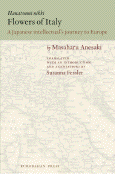Hanatsumi Nikki — The Flowers of Italy
Hanatsumi Nikki
The Flowers of Italy
By Masaharu ANESAKI
Translated with an introduction by
Susanna FESSLER
Masaharu Anesaki (1873-1949) was a leading member of Japan’s most interesting generation: the second generation of Meiji scholars, who lived in a highly-educated if not rarefied world that blended Japanese and Western traditions in a way that made them unique in their country’s long history.
This neglected classic of travel writing, philosophy, history, and comparative religion has been out of print in Japan for nearly a century. Its publication in English translation will open a fascinating vista for scholars and general readers, into the mind of modern Japan — as it stood at the crossroads of modernity.
In the late fall of 1907, Anesaki left Japan to travel around the world on a travel grant from the Kahn Foundation, a philanthropic organization that funded scholars’ overseas travel in the interest of promoting international understanding. Three months of his journey in the spring of 1908 were spent in Switzerland and Italy. He wrote at length about his experience, focusing on a few key subjects: St. Francis of Assisi, whom he admired, the painter Fra Angelico, whom he also admired, and their connection (as he saw it) to the Japanese Buddhist saint Hōnen.
Published in 1909, Hanatsumi Nikki is the record of his travels in Italy. But it is more than a memoir: it is an extended meditation on art, human life, European and Japanese culture, Buddhism, Christianity, and faith. Anesaki was a leading member of a generation of Japanese scholars and public intellectuals who helped to introduce Japan to the West. He also attempted to integrate his understanding of Western culture in his own study of Japanese religion. The full range of his erudition, sensibility, and passionate humanity shines through the pages of The Flowers of Italy.
This translation by Susanna Fessler includes the text of Anesaki’s article ‘How Christianity Appeals to a Japanese Buddhist’.
The book references numerous works of art, and many of these are available on the Web as listed in the appendix and on this PDF with clickable links. This PDF may be freely distributed.
Reviews and articles:
This fascinating and beautiful book from a century ago conveys to us a new world viewed through the eager eyes of a pilgrim to the West. Like star-gazers who know the light we see has taken centuries or millennia to reach our eyes, we wonder, as we read, how much of this world should still be available to our own senses should we embark on the journey taken by diarist/essayist Masaharu Anesaki so "long" ago.
Read complete review by Robert M. Price
...the very personal record of Anesaki's travels in Italy in 1908 holds up a mirror not only to the thoughts of a Meiji gentleman, consciously immersing himself in Western culture, but also to the period itself. This is not just another travelogue, but represents the attempts of a humane thinker to see the common links which exist in human feelings as they express themselves in art, religion and in the human response to nature.
Read complete review by Antoinette Fawcett, from "In Other Words"
Susanna Fessler examines the unique challenges of translating texts like this one, and discusses some of the issues encountered and resolved during the translation, in an article entitled "Translating Catholicism through the Buddhist Tradition."
Republished with permission of the British Centre for Literary Translation.
Read the entire article <here>.
Details:
- xxvii + 336 pages
- Trade paperback 6" x 9" (152 mm x 228 mm)
- ISBN: 978-4-902075-27-4
- Photograph of Masaharu Anesaki by courtesy of the Institute of Nichiren Buddhist Studies, Rissho University.
Masaharu Anesaki (1873-1949) was one of the most important figures in the development of religious studies in Japan. Born in Kyoto, he traveled widely as a young man, pursuing studies in India and Europe, and later served as a visiting professor at Harvard University. It was during this time that he began work on his most famous book, the pioneering History of Japanese Religion (published in 1930). A series of lectures from the same period led to Art, Life, and Nature in Japan (published in 1933). Anesaki was a model scholar, and a compassionate and profound observer of his own culture and those he visited. He spent his working life at the University of Tokyo as a professor of religion. In the latter half of the 1920s he was responsible for restoring the University's library, which had been destroyed in the great Kanto earthquake of 1923.
Susanna Fessler is Chair of the Department of East Asian Studies at the University at Albany, State University of New York. She obtained her doctorate in East Asian Literature from Yale in 1994. Professor Fessler has lived, studied, and taught in America, Japan, Taiwan, and the People’s Republic of China. Her current research involves Meiji period travelogues of the West, specifically of Japanese travelers in America and Europe. Her publications include Wandering Heart: The Work and Method of Hayashi Fumiko (1998, State University of New York Press).
